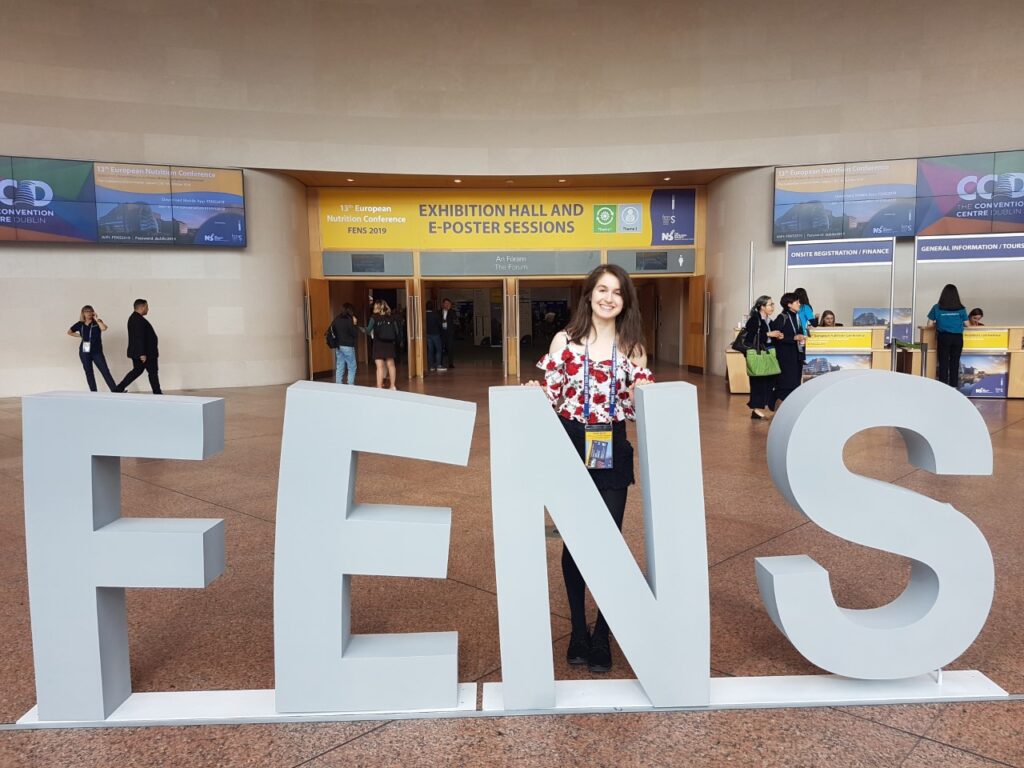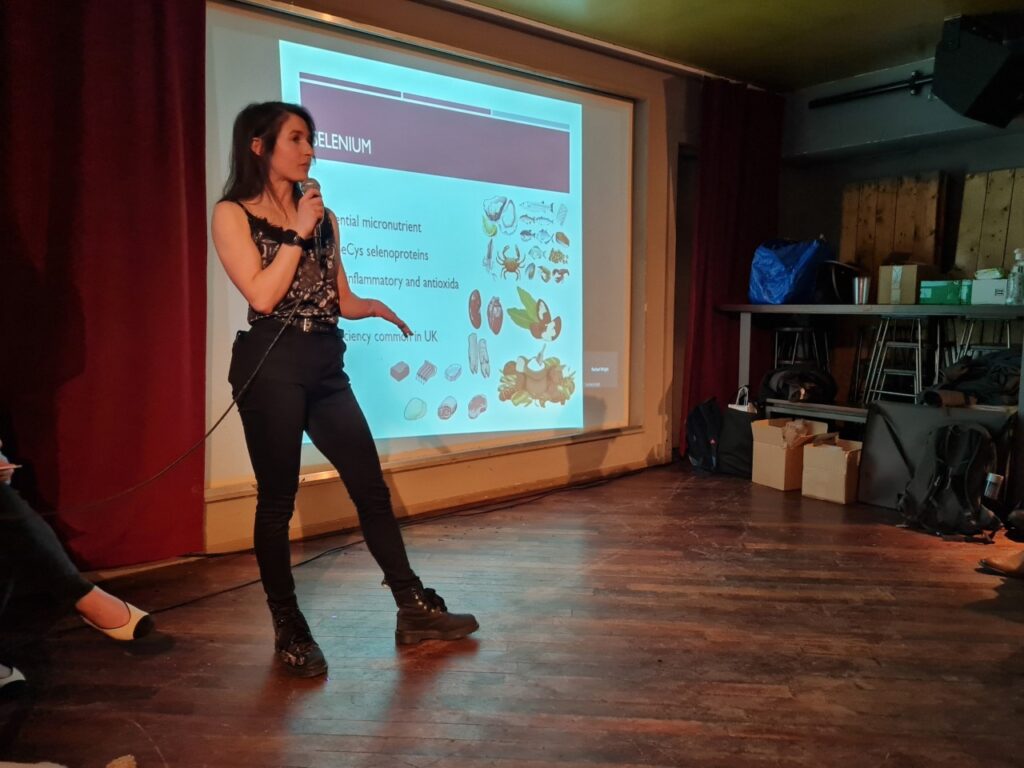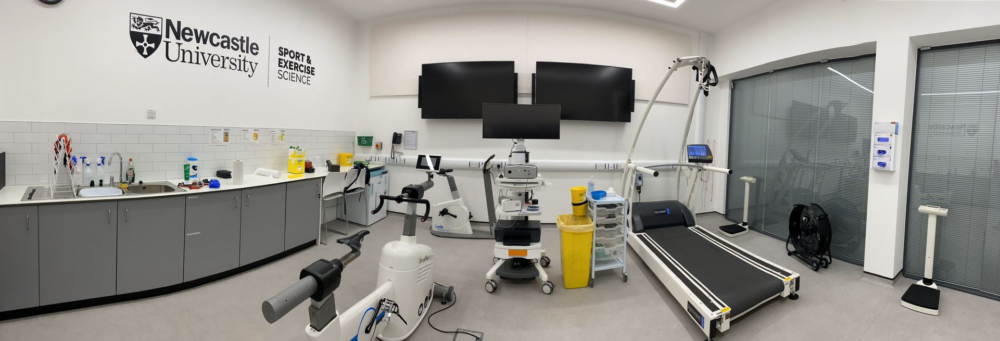By Giorgia Perri
My PhD within the Human Nutrition & Exercise Research Centre is now coming to an end which has allowed for reflection on my learning and understanding during the programme. My PhD focused on the effect of nutrition, specifically selenium, on musculoskeletal ageing. Before I embarked the PhD programme, like many others, I did not know a whole lot about selenium. I’d noticed it on some multivitamins I was taking, but after reading about this essential micronutrient, it soon became clear how important selenium is for human health, and how it could be involved in the ageing processes of muscle and bone. Selenium is incorporated into the human body as selenoproteins which exert different effects. Most selenoproteins have antioxidant effects that can mitigate the negative effects of excessive reactive oxygen species such as DNA damage. With age there is an increase in these reactive oxygen species which is thought to contribute to the ageing phenotype and disease, including reduced musculoskeletal function. It’s crucial that research is maintained in this area as populations are on the rise and living longer, but not necessarily in good health. One major issue older adults face is a decline in their musculoskeletal function, which can be associated with osteoporosis and sarcopenia. The rationale behind my PhD was further enhanced as experiments involving animal models had found effects of selenium deficiency or supplementation on musculoskeletal function. For example, in selenium-deficient rats, studies have found abnormal skeletal growth and poor bone health 1,2 and lower bone mineral density and femur ash weight 3.

Despite these experimental findings, the research was, and still is, lacking in human studies. A handful of promising observational studies have found associations between low serum selenium and markers of musculoskeletal strength like hand grip strength 4 and bone mineral density in older women 5 and older men 6. However, none of these studies to date have explored the long-term effects of selenium, analysed a variety of selenium doses or biomarkers of status or studied very old adults (≥ 85 years). This is what my PhD involved through exploring the effect of selenium on MSK ageing using two different study designs, observational (prospective) and experimental (randomised controlled trial).
The prospective analyses of my PhD used data obtained from the Newcastle 85+ Study. This was a large, longitudinal, single-birth year cohort residing in Newcastle upon Tyne. The study set out to explore the health trajectories of very old adults (≥ 85 years) and factors influencing these. During my MRes analyses I used the same data exploring the effect of dietary selenium intake on musculoskeletal function. Over half of the participants were consuming below the lower reference nutrient intake, a recommended intake to meet the needs of 2.5 % of a population, which equates to 40 µg/d 7. At baseline, those with lower intakes were associated with lower hand grip strength, but the association was not maintained during the 5 year follow up. This initial analysis was helpful in discovering that, as suspected, selenium intakes were suboptimal in very old adults, however, there are some limitations to dietary nutrient estimations, therefore, serum biomarkers of selenium status were measured as part of my PhD in 757 samples. These were analysed at Charité University, Berlin in Prof Lutz Schomburg’s lab that I also got to visit and found really interesting. The biomarkers of selenium status were serum selenium and two selenoproteins, glutathione peroxidase 3 (GPx3) and selenoprotein P (SePP).

Like the suboptimal selenium intake, this population also had suboptimal selenium status for serum selenium, however, surprisingly, GPx3 activity was considered adequate. It was also found that the selenoproteins were correlated linearly with serum selenium, further suggesting a lack of full selenoprotein expression. Taking this further, the associations between the biomarkers of selenium status and musculoskeletal function were explored. At baseline, there was no association between biomarkers of selenium status and hand grip strength or physical performance. However, there were negative associations between each of the selenium biomarkers and disability and GPx3 activity at baseline was negatively associated with change in prevalence of sarcopenia after 3-year follow-up.
The experimental analyses of my PhD used data obtained from the PRECISE study. This was a large, placebo-controlled randomised controlled trial using selenium-yeast supplementation in different doses (100, 200, 300 µg/d) for 5 years in 481 participants. In this study, plasma selenium was measured and retrospectively, biomarkers of bone turnover were measured. Selenium increased plasma selenium in a dose-dependent manner, suggesting good compliancy to the supplementation. However, supplementation had no significant effect on the bone turnover markers. This may be since the populations baseline selenium was 86.5 µg/l which is considered adequate whereby supplementing on top of this may provide no additional benefit. This was published in Journal of Bone and Mineral Research, see the link here https://pubmed.ncbi.nlm.nih.gov/36093566/
My PhD contributed to the field of research in selenium and musculoskeletal function by enhancing previous knowledge for example using longer study durations or more biomarkers of selenium. Despite the lack of significant findings it is still important to note the suboptimal selenium status in very old adults which requires attention for health optimisation. I would like to explore this further looking at other musculoskeletal outcomes, such as falls and fractures.
References
- Moreno-Reyes, R., Egrise, D., Nève, J., Pasteels, J. L., Schoutens, A. (2001) ‘Selenium deficiency-induced growth retardation is associated with an impaired bone metabolism and osteopenia’, Journal of Bone and Mineral Research, 16, pp. 1556-1563.
- Hurt, H. D., Cary, E. E. and Visek, W. J. (1971) ‘Growth, reproduction, and tissue concentrations of selenium in the selenium-depleted rat’, J Nutr, 101(6), pp. 761-6.
- Sasaki, S., Iwata, H., Ishiguro, N., Habuchi, O., & Miura, T. (1994) ‘Low-selenium Diet, Bone, and Articular Cartilage in Rats’, Nutrition, 10(6) pp. 538-543.
- Beck, J., Ferrucci, L., Sun, K., Walston, J., Fried, L. P., Varadhan, R., Guralnik, J. M. and Semba, R. D. (2007) ‘Low serum selenium concentrations are associated with poor grip strength among older women living in the community’, BioFactors, 29(1), pp. 37-44.
- Hoeg, A., Gogakos, Apostolos, Murphy, Elaine, Mueller, Sandra, Köhrle, Josef, Reid, David M., Glüer, Claus C., Felsenberg, Dieter, Roux, Christian, Eastell, Richard, Schomburg, Lutz, Williams, Graham R. (2012) ‘Bone turnover and bone mineral density are independently related to selenium status in healthy euthyroid postmenopausal women’, The Journal of clinical endocrinology and metabolism, 97, pp. 4061-4070.
- Beukhof, C. M., Medici, M., van den Beld, A. W., Hollenbach, B., Hoeg, A., Visser, W. E., de Herder, W. W., Visser, T. J., Schomburg, L. and Peeters, R. P. (2016) ‘Selenium Status Is Positively Associated with Bone Mineral Density in Healthy Aging European Men’, PLoS One, 11(4), pp. e0152748.
- Perri, G., Mendonça, Nuno., Jagger, Carol., Walsh, Jennifer., Eastell, Richard., Mathers, John C., Hill, Tom R. (2020) ‘Dietary selenium intakes and musculoskeletal function in very old adults: Analysis of the newcastle 85+ study’, 12, Nutrients, pp. 1-22.
